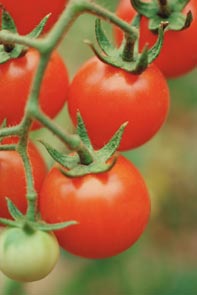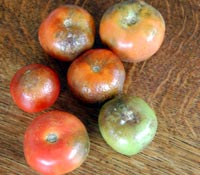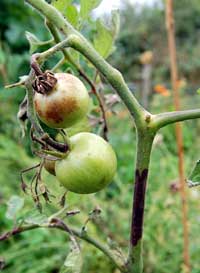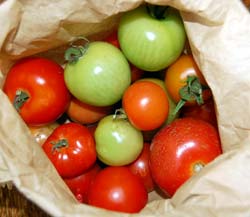Growing Tomato Plants for a Summer Feast of Good Food
Growing tomato plants - a short and easy guide to the basics.
It's lovely to be able to grow your own tomatoes. Whether you want to become greener by growing more of your own food - and so saving on food miles - or whether you are interested in growing organic tomatoes because they taste so much better, tomatoes are a good choice.
Either way, they are another way to green your lifestyle. But there are pitfalls!
Planting tomatoes is not so very difficult and with a little luck and practice, you could be in the enviable position of wondering just how to handle your glut of gorgeous fresh tomatoes!
Lots of people grow their own, but tomatoes do have a reputation for being a bit tricky to grow - at least in Britain and other countries where damp weather is common.

Growing tomato plants: A profusion of homegrown tomatoes
Photo by Théo de Belgeonne
Growing tomatoes -
- are they really that difficult?
Growing tomato plants isn't really that difficult - if you are lucky with the weather or you live in an area with the right climate! If you don't have the right climate, you need to pay a lot of attention to making conditions as near-right as possible. They are a bit fiddly too, needing tying and feeding regularly. They need a lot of attention and some good luck with the weather if you want to grow a successful crop outside.
Too chilly and you will struggle to get the flowers to develop into fruit; too dry and the fruit can be small and tough and splits when the rain returns; too wet and blight sets in! You have been warned!
That said they are the most fantastic fruits, tasty, versatile and full of vitamins, so if we haven't put you off, here's how to proceed. All the cultivation notes here are for temperate areas.
Click here for some good tomato growing books and tomato recipes.
Growing tomato plants:
Growing tomato plants - how to begin
Growing tomato plants from seed
If you want to grow tomatoes from seed you need to start them off in early spring under cover. Tomato seeds need reasonably warm conditions (18 degrees Celsius or better) to germinate well so, if your climate is cool, put the seed trays onto a sunny windowsill or other warm place.
Whether you want to become greener by growing more of your own food - and so saving on food miles - or whether you are interested in growing organic tomatoes because they taste so much better, tomatoes are a good choice.
Seeds should be scattered thinly over potting compost and then covered with more compost. It's best to add cling film or paper so that they do not dry out too quickly.
Keep the trays moist and when the seedlings appear remove the cling film. If you don't have cling film (or you want to be super-green because the cling film lands up in the refuse bin), just check to keep the seedling trays moist every day.
You must not over water though because you risk the tomato seedlings rotting near the bottom of the stem (damping-off). It may be wise to use tap water rather than water from your water butt for watering your emerging tomato plants. Rain water may contain fungal spores which can lead to damping off infection.
Growing tomato plants:
Using a windowsill
If you are using a windowsill, turn the trays every day or two to help the seedlings to grow evenly. If you don't do this they will become bent over as they grow towards the sun. Growing tomato seedlings on a windowsill is a practical solution for many people because you can usually keep them at around the desired starting temperature with very little effort. They can be a bit messy, so a windowsill which will wipe down easily afterwards is best.
Some people use an airing cupboard to start them. Maybe this is only a sensible idea if you can keep your airing cupboard free from cats or kids! At least there should be plenty of warmth. Of course the seedlings need to be moved into the light as soon as they germinate and push up through the potting compost.
It is important to pot up and move your young growing tomato plants into strong direct light as soon as is practical. Plants grown indoors can be thin and leggy if they do not get enough light.
Growing tomato plants:
Growing tomato plants on
Transplanting
When the seedlings are about 1-2 inches high (3-5cms) transplant them into small individual pots. These should be about 3 inches across the top (7-8cms).
Ease each seedling away from the others with a pencil end or small stick, being careful not to damage the roots as far as possible. Lift the seedling by the leaves, not the stem as it damages too easily at this stage.
Make a hole which is more than big enough for the roots to sit in comfortably. Feed in more compost over the roots and then water the pot immediately. This allows the roots to grow on quickly. Firm the compost around the rootlets to ensure good contact.
Keep your pots in a warm light place, preferably around 18-20 degrees centigrade. Keep turning them every day or two if the light source is very uneven (as in a windowsill).
When the seedlings get to about 6-8 inches (15-20cms) tall you should pot them on again into largish pots. You have to keep on doing this until the weather warms up enough to put them outside. Use a good quality organic peat-free potting mix or good quality fresh soil taken from somewhere tomatoes have not been grown in recent years.
Watering tomato plants in pots must, of course, be done regularly.
Life in a pot has its restrictions, too. When growing tomato plants it's important to pot them on as often as needed - otherwise your plants will be slow to grow and will not develop a vibrant green colour. I was recently planting tomatoes which had been grown in pots. I found a self-seeded garden tomato growing happily nearby which was as big as the greenhouse reared ones I was planting out - but far more robust looking and with a healthy, deep green colour. The greenhouse reared tomatoes are now catching up.
Maybe there is scope for a naturalised East Anglian variety of tomato plant! (One of my two self-seeded tomatoes did go on to produce a worthwhile crop.)
Fortunately, most tomato plants which are a bit pot-bound and neglected will catch up enough, given time and care.
Growing tomato plants:
Hardening off your tomatoes
As the daytime temperature rises to around 16-20 degrees or more, put them outside for a while each day to harden them off (this means to make them weather hardy). You are never going to make most tomatoes really weather hardy as they are a sub-tropical species. But if they are too used to indoor constant temperatures their growth becomes sappy and weak. Planting tomatoes outdoors gives better all-round light for maximum healthy growth.
Remember to bring them inside again before the temperature falls towards evening, otherwise you may lose them after all your hard work.
When you have hardened off your plants for a few days (preferably a week or more) you can start to think about planting them out.
Choose a sunny, well-drained site, preferably out of the wind, too. It's not a good idea to plant them near potatoes or where potatoes have been the year before. They are from the same plant family (Solanaceae) so they share some diseases. Don't put them out if the night temperature is still regularly below 7 degrees and certainly not if there is still any chance of frost. If you can measure your soil temperature, at least 10 degrees and above is OK.
In Britain we usually don't put tomatoes out until around the end of May or start of June. If your tomatoes do get chilled it will set them back even if it does not kill them. It's good to have some fleece or cloches handy for if the weather does throw a sudden chill your way.
are available from Amazon.
Growing tomato plants:
Planting tomatoes out
|
 |
Try to plant tomatoes out when the weather is mild but the soil is damp. If this just ain't going to happen, then water the hole you dig before you put the plant into it.
Dig a hole which is more than big enough to take the spread out root of your young tomato plant. Tip the plant pot upside down while spreading your fingers around the top of the pot and the plant stem so that the plant can't fall out without you catching it. Give the pot a couple of sharp taps on the bottom with a spade or other hard metal tool and it should then release the plant. If it doesn't, try squeezing the plant pot gently - this only works with plastic ones of course!
Spread the roots out in the hole so that they are well in contact with as much soil as possible. Growing tomato plants depend upon their roots for water and nutrients, so good soil contact is vital.
Put a cane or other support into the ground without damaging the roots. Water the plant with lots of water. Now fill the soil back in, firm it down with your feet carefully (but not too hard) and tie the plant to the support, preferably with bio-degradable twine.
Water again the next day. After that the plant should be establishing itself and the roots will begin to find the moisture and nutrients in the soil.
Tomatoes like a fair amount of water, so you may need to water your tomato crop regularly if conditions are dry. Planting tomatoes with a good much of well rotted compost or other material is one way to cut down on watering.
Growing tomato plants:
Spacing
Put your tomato plants at least 18 inches (45cms) away from each other, preferably more. Growing tomatoes need plenty of light and air to thrive and they won't grow so well if they are crowded. You can always use some of the ground space between to inter-crop small salad plants or basil. Basil and carrots are good companion crops to use when growing tomato plants.
Tomato plant support
Proper tomato plant support is important for the health and growth of your tomato plants. You can use locally grown wood (e.g. hazel) or bamboo canes or you can buy tomato plant supports. In my view, this is only worth while if you are very pressed for time. If you do go for commercial supports, always check for sustainability and buy products which should last for many seasons.
The growing season - various tasks
Growing tomato plants:
Regular feeding for success
Tomatoes are hungry plants and do best if they are given regular feeds of high potash fertiliser. You can use a proprietary brand of tomato food to make life easier. There are good organic tomato fertilisers on the market though they can be hard to find in garden shops. You can make your own, or use Blood Fish and Bone or Seaweed feeds.
Aim to feed your crop about once a week throughout the growing season and you should get a good crop. If you are using a liquid feed, water the plants low down so that they don't get too wet. Tomatoes don't much like wet leaves.
Growing tomato plants:
Managing your tomato plants
Most tomatoes need regular tying to keep them upright as they grow and you also need to pinch out side shoots on most varieties. This can be surprisingly time consuming, especially when you miss some and they develop and start producing side shoots of their own!
Look for what looks like a baby tomato plant growing right between the leaf and the stem. Be careful that it's not a developing flower stalk - leave it for a few days to be sure if you are new to this. Nip it out with your fingers or use a small sharp knife. This helps the plant to concentrate on producing flowers rather than more straggly growth.
Growing tomato plants:
As the crop matures..
As the plant matures you may need to beef up its support as tomatoes can be quite heavy and you don't want the fruit to be dragging on the ground.
When the plant has 5 trusses (flower stalks) you need to nip off the growing tip so that more don't develop. This is to prevent you from having loads of immature fruit and flowers - and no mature ones. You may be able to grow more trusses if you have a longer growing season than we have here in Britain.
There are now tomato supports available in the shops which should make life easier. Tomato cages discreetly support the whole plant and allow good access. Amazon sells tomato cages which you can see here.
Innovations such as the upside down tomato can make management easier. The tomato grows downwards from a planter or hanging basket, making the fruit easy to pick. Hanging tomato plants certainly look stylish and are a bit of a conversation piece. I haven't yet tried growing tomato plants this way.
Growing tomato plants
Tomato growing tips
There's plenty more to learn about growing tomatoes the organic way. You can grow them in pots and planters, in greenhouses, on the patio, in your sun room or conservatory.
One useful tip is to grow them in re-cycled plastic bags, preferably heavy duty ones, against a wall. If the weather gets too horrible, you can just move them to somewhere more sheltered for a day or two, especially while they are still fairly small. (Support the roots carefully when moving - and don't do it too much!)
Grow bags also do well against a sheltering wall as the warmth of the wall acts as a radiator after the sun leaves - and reflects heat and light during sunshine hours. Obviously, you have to pick a sunny, sheltered wall. My neighbour gets good results with this method on an east facing wall. You can just plant them in soil close to a good wall, too, if the soil is suitable.
Use a double layer of plastic bags and a good quality growing medium. Tie them to supports and water and feed them well. I think this works a little better than grow bags because the soil isn't quite so compacted. You shouldn't let the soil be too loosely arranged in the bag, though. Roots need a certain amount of resistance to grow into - mainly because they need good soil contact to get at those all-important nutrients. Don't move them often though because you disturb the roots each time.
Pests and problems
Growing tomato plants:
Problems growing tomatoes
There are many possible problems that crop up when growing tomatoes.

Perhaps the most tricky of all is tomato blight. This is a fungus that lives in the soil and infects tomato plants in wet seasons.
There is no real cure (organic or not) but it helps to plant out your plants well apart from each other in an airy spot so that moisture dries off quickly. Avoid watering directly onto leaves too.
It is best to burn blight-infected plants so that the organism does not infect the soil. If you suffer blight one year make sure you grow your tomatoes somewhere fresh the next year (you should do this in any case).

If you do suffer tomato blight because of a spell of bad weather, try removing all the affected fruits and leaves and keep a vigilant eye on what's left. You may still be able to salvage a small crop if the weather stays good for a spell. I've tried this and it sometimes works. Most gardening books just advocate that you burn the lot. They are probably right but when you've worked all year you'll try anything!
It's always best to practise crop rotation of course, to reduce the danger of tomato blight continuing in the soil. Some varieties are more blight-resistant than others, so if you live in a damp climate seek out these varieties.
Picture, above: blighted tomatoes are useless. Picture below: a blighted tomato plant showing characteristic signs of damage
Growing tomato plants:
Tomato horn worm
Another tomato growing problem if you are in America (north or south)is the tomato horn worm. This impressive beast is actually the larva of a species of moth. It enjoys eating tomato leaves and can be quite damaging. Pick off the larvae by hand (or glove if you are squeamish!)
Many common problems with growing tomatoes are avoided by practising good garden hygiene and using companion plants. Basil grows well with tomatoes and garlic offers some protection.

Picture, above: tomatoes ripen faster in a brown paper bag. A banana can be added to really speed things up - bananas give off chemicals which speed ripening
Growing tomato plants:
Some good varieties to try
Gardeners Delight is a great salad tomato. It grows lots of trusses of small sweet fruit.
Giant Liscio is a great big tasty beef tomato. It tends to mature later than smaller tomatoes. Not very blight resistant.
Moneymaker produces a bumper crop of medium sized tomatoes but the flavour is nothing to write home about. Nevertheless, if you are planning on making lots of soups and purées it's a good choice.
So, have a go if you have the time! Growing tomato plants is quite good fun and tomatoes are such a tasty addition to your summer table. There is an excellent tomato soup recipe in the Green Recipe Book to try.

Custom Search
|
Other pages related to growing tomato plants that might interest you:
Fresh Tomato Recipes for that Glut!
|
Greenfootsteps Home - for more easy green living ideas

| Tweet |

Footprints
- an occasional e-zine from Greenfootsteps
If you would like to receive the e-zine, please just sign up below.






New! Comments
Have your say about what you just read! Leave me a comment in the box below.